Guided Review of Nominated Literature: COPD Patient Exacerbation Study
VerifiedAdded on 2021/04/21
|10
|2672
|30
Homework Assignment
AI Summary
This assignment presents a guided review of a qualitative study investigating patients' experiences in identifying and managing Chronic Obstructive Pulmonary Disease (COPD) exacerbations. The review delves into the background of the study, highlighting the significance of understanding how patients perceive and handle exacerbations to potentially reduce hospital admissions. It examines the research design, specifically grounded theory, and its suitability for exploring patients' understanding and management strategies. The review analyzes the sampling techniques, participant characteristics, and inclusion/exclusion criteria. Furthermore, it explores data collection methods (interviews), data analysis techniques, and the study's findings regarding visible and invisible symptoms, self-management techniques, and healthcare access. The assignment also considers the transferability of the findings to other settings, such as the management of Borderline Personality Disorder.
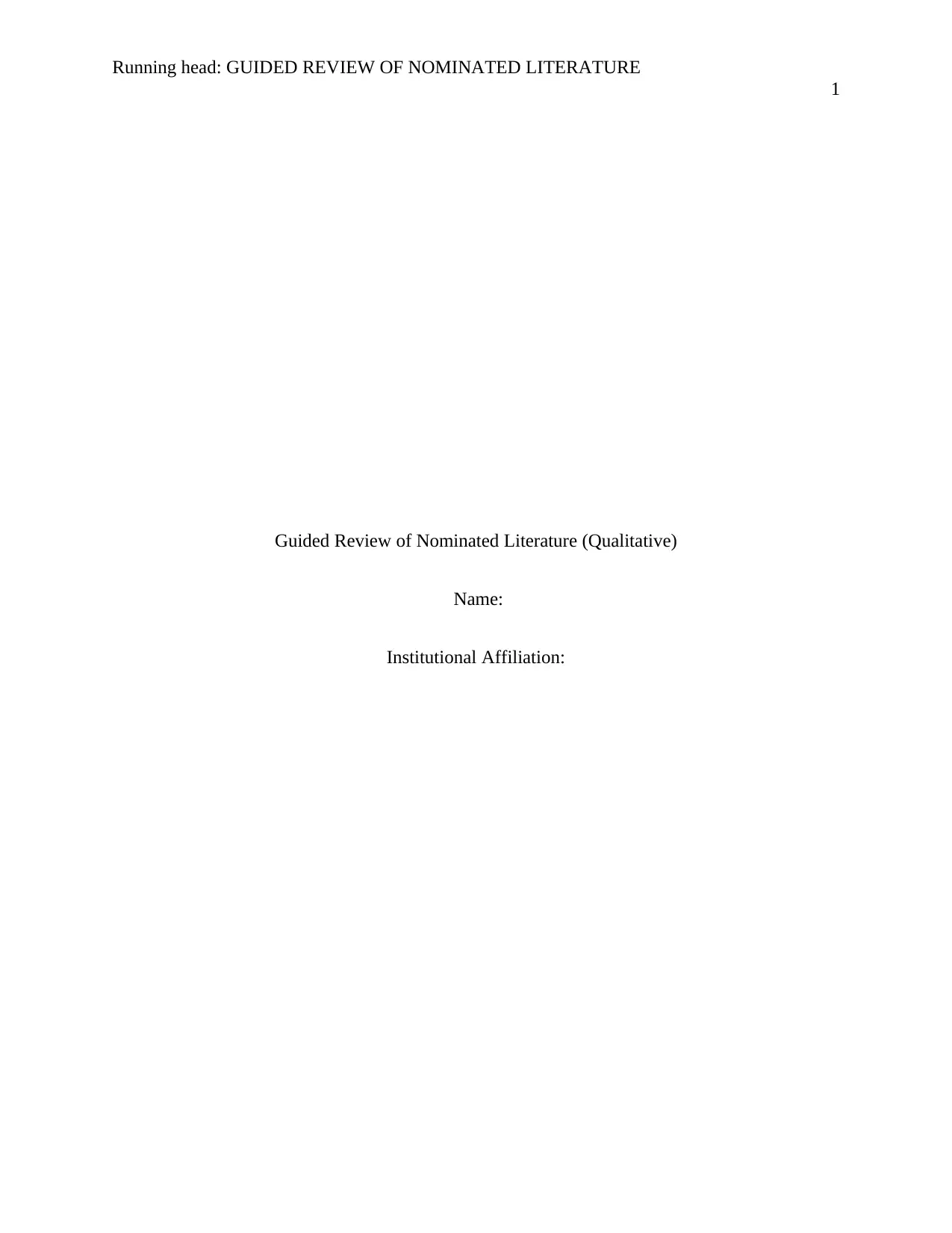
Running head: GUIDED REVIEW OF NOMINATED LITERATURE
1
Guided Review of Nominated Literature (Qualitative)
Name:
Institutional Affiliation:
1
Guided Review of Nominated Literature (Qualitative)
Name:
Institutional Affiliation:
Paraphrase This Document
Need a fresh take? Get an instant paraphrase of this document with our AI Paraphraser
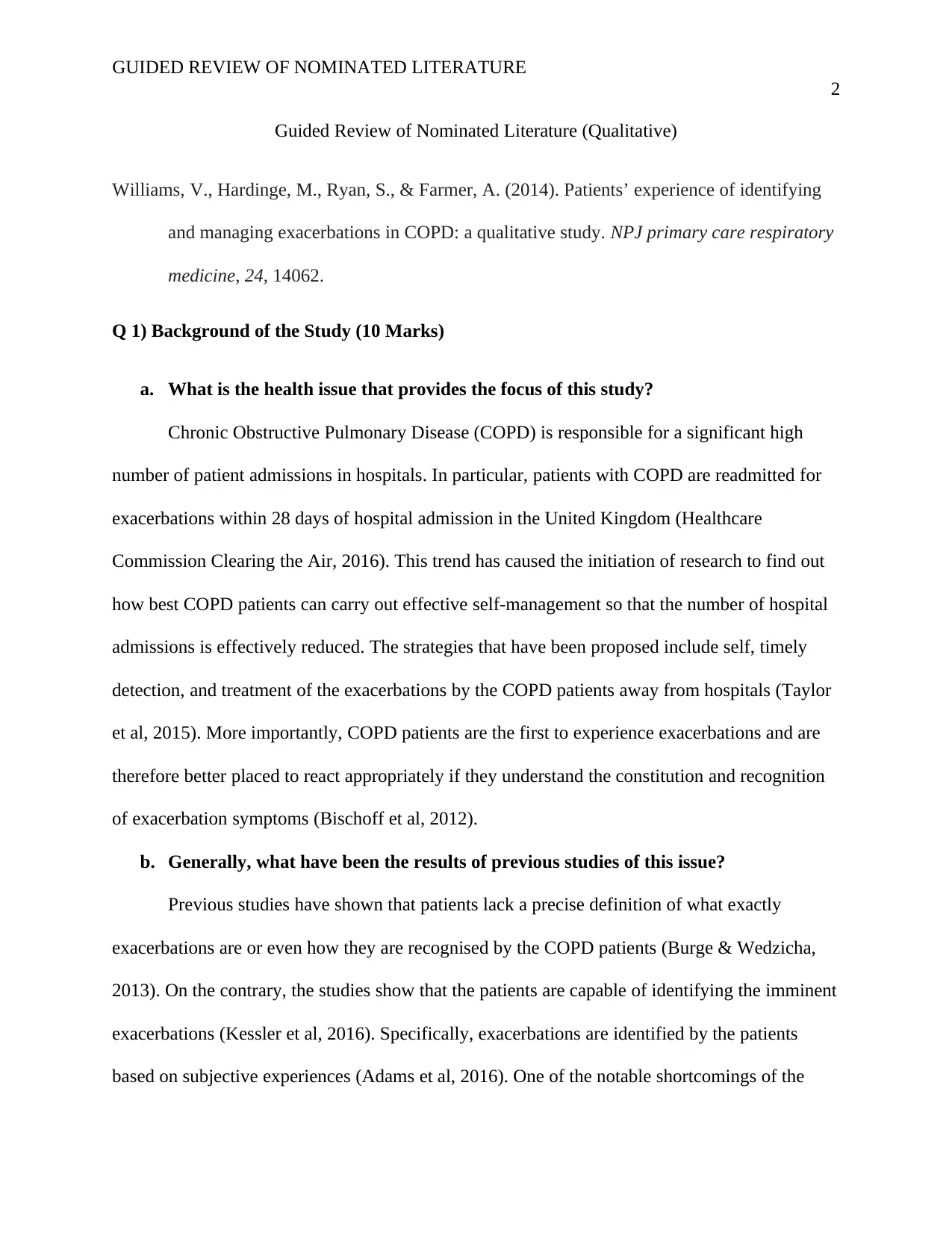
GUIDED REVIEW OF NOMINATED LITERATURE
2
Guided Review of Nominated Literature (Qualitative)
Williams, V., Hardinge, M., Ryan, S., & Farmer, A. (2014). Patients’ experience of identifying
and managing exacerbations in COPD: a qualitative study. NPJ primary care respiratory
medicine, 24, 14062.
Q 1) Background of the Study (10 Marks)
a. What is the health issue that provides the focus of this study?
Chronic Obstructive Pulmonary Disease (COPD) is responsible for a significant high
number of patient admissions in hospitals. In particular, patients with COPD are readmitted for
exacerbations within 28 days of hospital admission in the United Kingdom (Healthcare
Commission Clearing the Air, 2016). This trend has caused the initiation of research to find out
how best COPD patients can carry out effective self-management so that the number of hospital
admissions is effectively reduced. The strategies that have been proposed include self, timely
detection, and treatment of the exacerbations by the COPD patients away from hospitals (Taylor
et al, 2015). More importantly, COPD patients are the first to experience exacerbations and are
therefore better placed to react appropriately if they understand the constitution and recognition
of exacerbation symptoms (Bischoff et al, 2012).
b. Generally, what have been the results of previous studies of this issue?
Previous studies have shown that patients lack a precise definition of what exactly
exacerbations are or even how they are recognised by the COPD patients (Burge & Wedzicha,
2013). On the contrary, the studies show that the patients are capable of identifying the imminent
exacerbations (Kessler et al, 2016). Specifically, exacerbations are identified by the patients
based on subjective experiences (Adams et al, 2016). One of the notable shortcomings of the
2
Guided Review of Nominated Literature (Qualitative)
Williams, V., Hardinge, M., Ryan, S., & Farmer, A. (2014). Patients’ experience of identifying
and managing exacerbations in COPD: a qualitative study. NPJ primary care respiratory
medicine, 24, 14062.
Q 1) Background of the Study (10 Marks)
a. What is the health issue that provides the focus of this study?
Chronic Obstructive Pulmonary Disease (COPD) is responsible for a significant high
number of patient admissions in hospitals. In particular, patients with COPD are readmitted for
exacerbations within 28 days of hospital admission in the United Kingdom (Healthcare
Commission Clearing the Air, 2016). This trend has caused the initiation of research to find out
how best COPD patients can carry out effective self-management so that the number of hospital
admissions is effectively reduced. The strategies that have been proposed include self, timely
detection, and treatment of the exacerbations by the COPD patients away from hospitals (Taylor
et al, 2015). More importantly, COPD patients are the first to experience exacerbations and are
therefore better placed to react appropriately if they understand the constitution and recognition
of exacerbation symptoms (Bischoff et al, 2012).
b. Generally, what have been the results of previous studies of this issue?
Previous studies have shown that patients lack a precise definition of what exactly
exacerbations are or even how they are recognised by the COPD patients (Burge & Wedzicha,
2013). On the contrary, the studies show that the patients are capable of identifying the imminent
exacerbations (Kessler et al, 2016). Specifically, exacerbations are identified by the patients
based on subjective experiences (Adams et al, 2016). One of the notable shortcomings of the
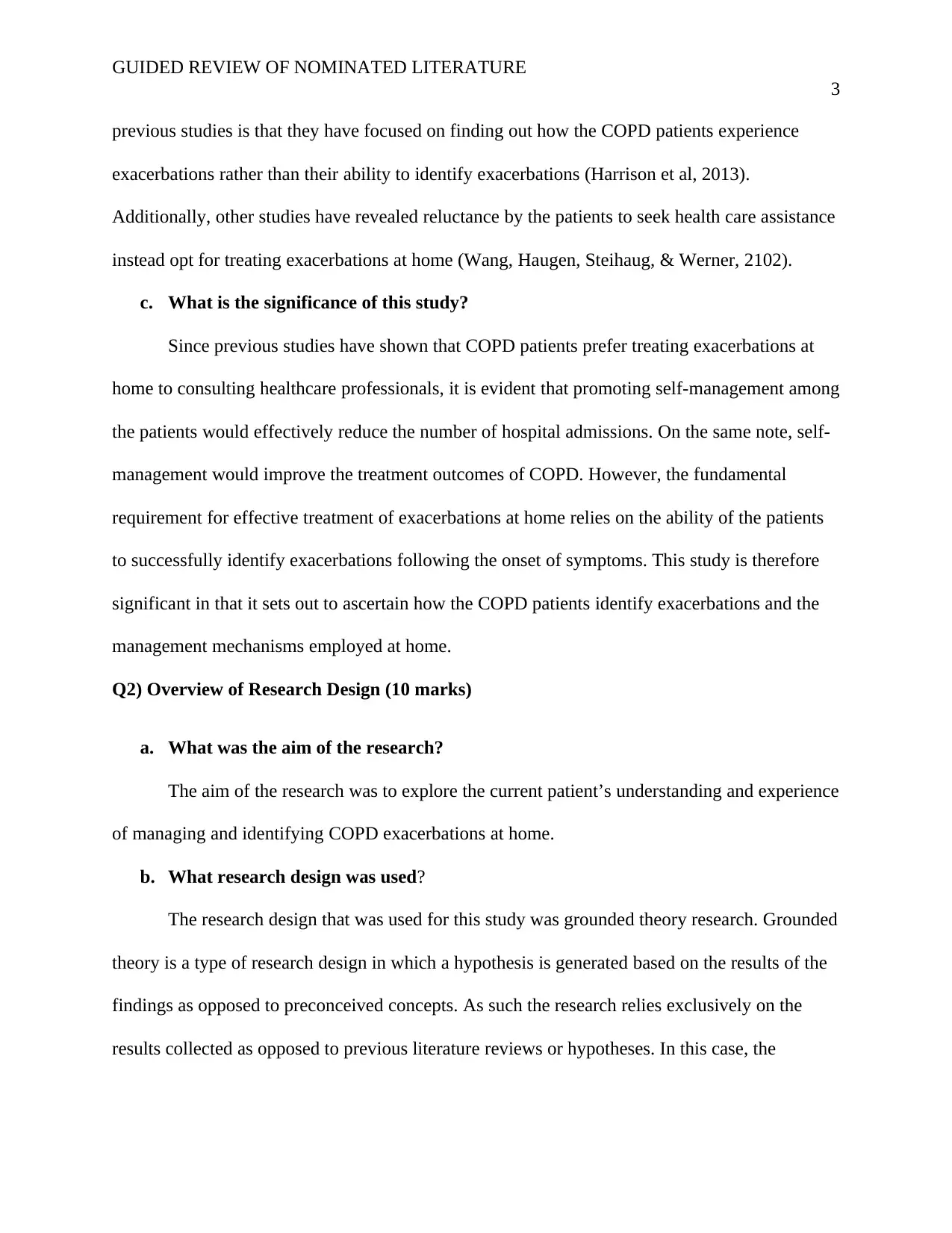
GUIDED REVIEW OF NOMINATED LITERATURE
3
previous studies is that they have focused on finding out how the COPD patients experience
exacerbations rather than their ability to identify exacerbations (Harrison et al, 2013).
Additionally, other studies have revealed reluctance by the patients to seek health care assistance
instead opt for treating exacerbations at home (Wang, Haugen, Steihaug, & Werner, 2102).
c. What is the significance of this study?
Since previous studies have shown that COPD patients prefer treating exacerbations at
home to consulting healthcare professionals, it is evident that promoting self-management among
the patients would effectively reduce the number of hospital admissions. On the same note, self-
management would improve the treatment outcomes of COPD. However, the fundamental
requirement for effective treatment of exacerbations at home relies on the ability of the patients
to successfully identify exacerbations following the onset of symptoms. This study is therefore
significant in that it sets out to ascertain how the COPD patients identify exacerbations and the
management mechanisms employed at home.
Q2) Overview of Research Design (10 marks)
a. What was the aim of the research?
The aim of the research was to explore the current patient’s understanding and experience
of managing and identifying COPD exacerbations at home.
b. What research design was used?
The research design that was used for this study was grounded theory research. Grounded
theory is a type of research design in which a hypothesis is generated based on the results of the
findings as opposed to preconceived concepts. As such the research relies exclusively on the
results collected as opposed to previous literature reviews or hypotheses. In this case, the
3
previous studies is that they have focused on finding out how the COPD patients experience
exacerbations rather than their ability to identify exacerbations (Harrison et al, 2013).
Additionally, other studies have revealed reluctance by the patients to seek health care assistance
instead opt for treating exacerbations at home (Wang, Haugen, Steihaug, & Werner, 2102).
c. What is the significance of this study?
Since previous studies have shown that COPD patients prefer treating exacerbations at
home to consulting healthcare professionals, it is evident that promoting self-management among
the patients would effectively reduce the number of hospital admissions. On the same note, self-
management would improve the treatment outcomes of COPD. However, the fundamental
requirement for effective treatment of exacerbations at home relies on the ability of the patients
to successfully identify exacerbations following the onset of symptoms. This study is therefore
significant in that it sets out to ascertain how the COPD patients identify exacerbations and the
management mechanisms employed at home.
Q2) Overview of Research Design (10 marks)
a. What was the aim of the research?
The aim of the research was to explore the current patient’s understanding and experience
of managing and identifying COPD exacerbations at home.
b. What research design was used?
The research design that was used for this study was grounded theory research. Grounded
theory is a type of research design in which a hypothesis is generated based on the results of the
findings as opposed to preconceived concepts. As such the research relies exclusively on the
results collected as opposed to previous literature reviews or hypotheses. In this case, the
⊘ This is a preview!⊘
Do you want full access?
Subscribe today to unlock all pages.

Trusted by 1+ million students worldwide
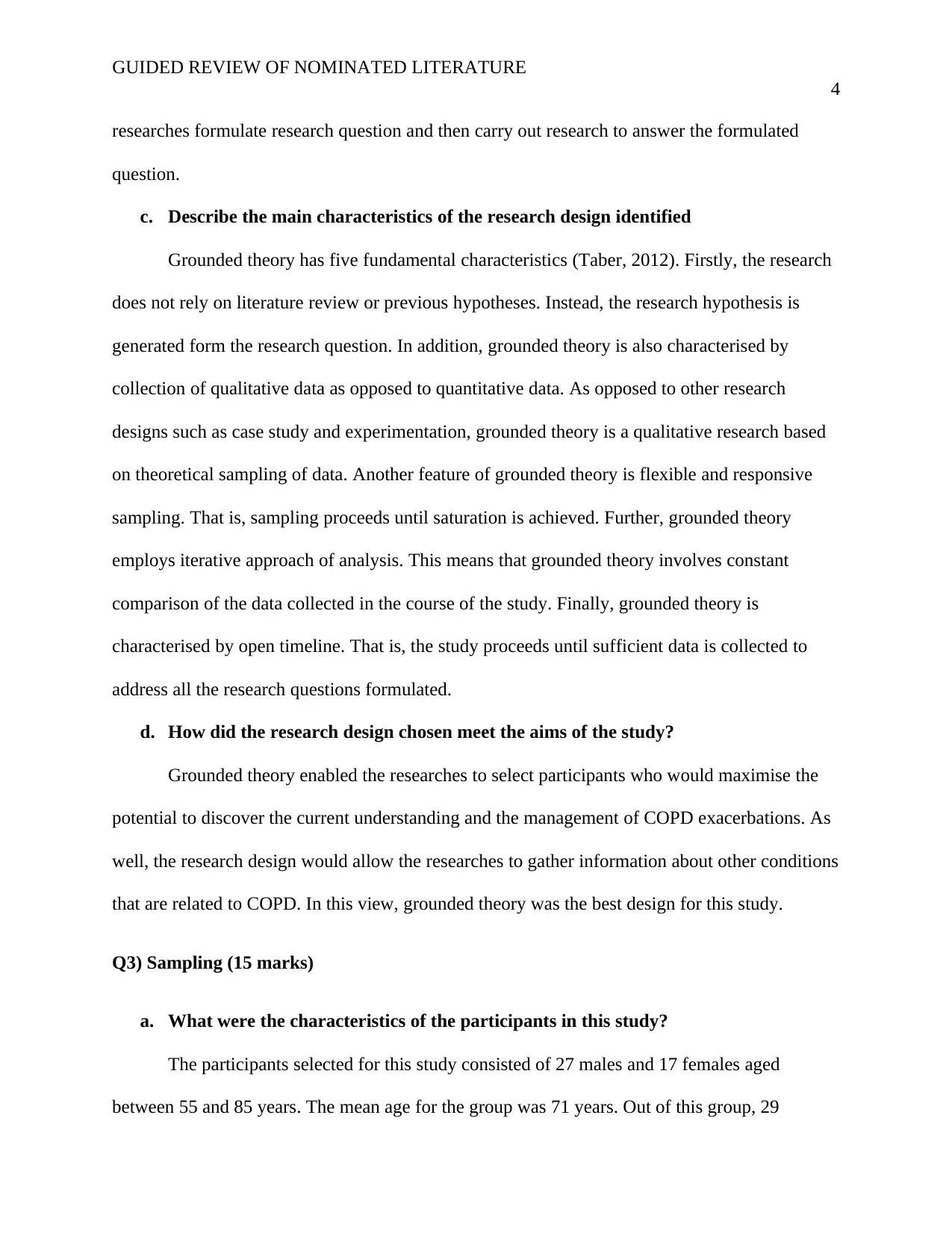
GUIDED REVIEW OF NOMINATED LITERATURE
4
researches formulate research question and then carry out research to answer the formulated
question.
c. Describe the main characteristics of the research design identified
Grounded theory has five fundamental characteristics (Taber, 2012). Firstly, the research
does not rely on literature review or previous hypotheses. Instead, the research hypothesis is
generated form the research question. In addition, grounded theory is also characterised by
collection of qualitative data as opposed to quantitative data. As opposed to other research
designs such as case study and experimentation, grounded theory is a qualitative research based
on theoretical sampling of data. Another feature of grounded theory is flexible and responsive
sampling. That is, sampling proceeds until saturation is achieved. Further, grounded theory
employs iterative approach of analysis. This means that grounded theory involves constant
comparison of the data collected in the course of the study. Finally, grounded theory is
characterised by open timeline. That is, the study proceeds until sufficient data is collected to
address all the research questions formulated.
d. How did the research design chosen meet the aims of the study?
Grounded theory enabled the researches to select participants who would maximise the
potential to discover the current understanding and the management of COPD exacerbations. As
well, the research design would allow the researches to gather information about other conditions
that are related to COPD. In this view, grounded theory was the best design for this study.
Q3) Sampling (15 marks)
a. What were the characteristics of the participants in this study?
The participants selected for this study consisted of 27 males and 17 females aged
between 55 and 85 years. The mean age for the group was 71 years. Out of this group, 29
4
researches formulate research question and then carry out research to answer the formulated
question.
c. Describe the main characteristics of the research design identified
Grounded theory has five fundamental characteristics (Taber, 2012). Firstly, the research
does not rely on literature review or previous hypotheses. Instead, the research hypothesis is
generated form the research question. In addition, grounded theory is also characterised by
collection of qualitative data as opposed to quantitative data. As opposed to other research
designs such as case study and experimentation, grounded theory is a qualitative research based
on theoretical sampling of data. Another feature of grounded theory is flexible and responsive
sampling. That is, sampling proceeds until saturation is achieved. Further, grounded theory
employs iterative approach of analysis. This means that grounded theory involves constant
comparison of the data collected in the course of the study. Finally, grounded theory is
characterised by open timeline. That is, the study proceeds until sufficient data is collected to
address all the research questions formulated.
d. How did the research design chosen meet the aims of the study?
Grounded theory enabled the researches to select participants who would maximise the
potential to discover the current understanding and the management of COPD exacerbations. As
well, the research design would allow the researches to gather information about other conditions
that are related to COPD. In this view, grounded theory was the best design for this study.
Q3) Sampling (15 marks)
a. What were the characteristics of the participants in this study?
The participants selected for this study consisted of 27 males and 17 females aged
between 55 and 85 years. The mean age for the group was 71 years. Out of this group, 29
Paraphrase This Document
Need a fresh take? Get an instant paraphrase of this document with our AI Paraphraser
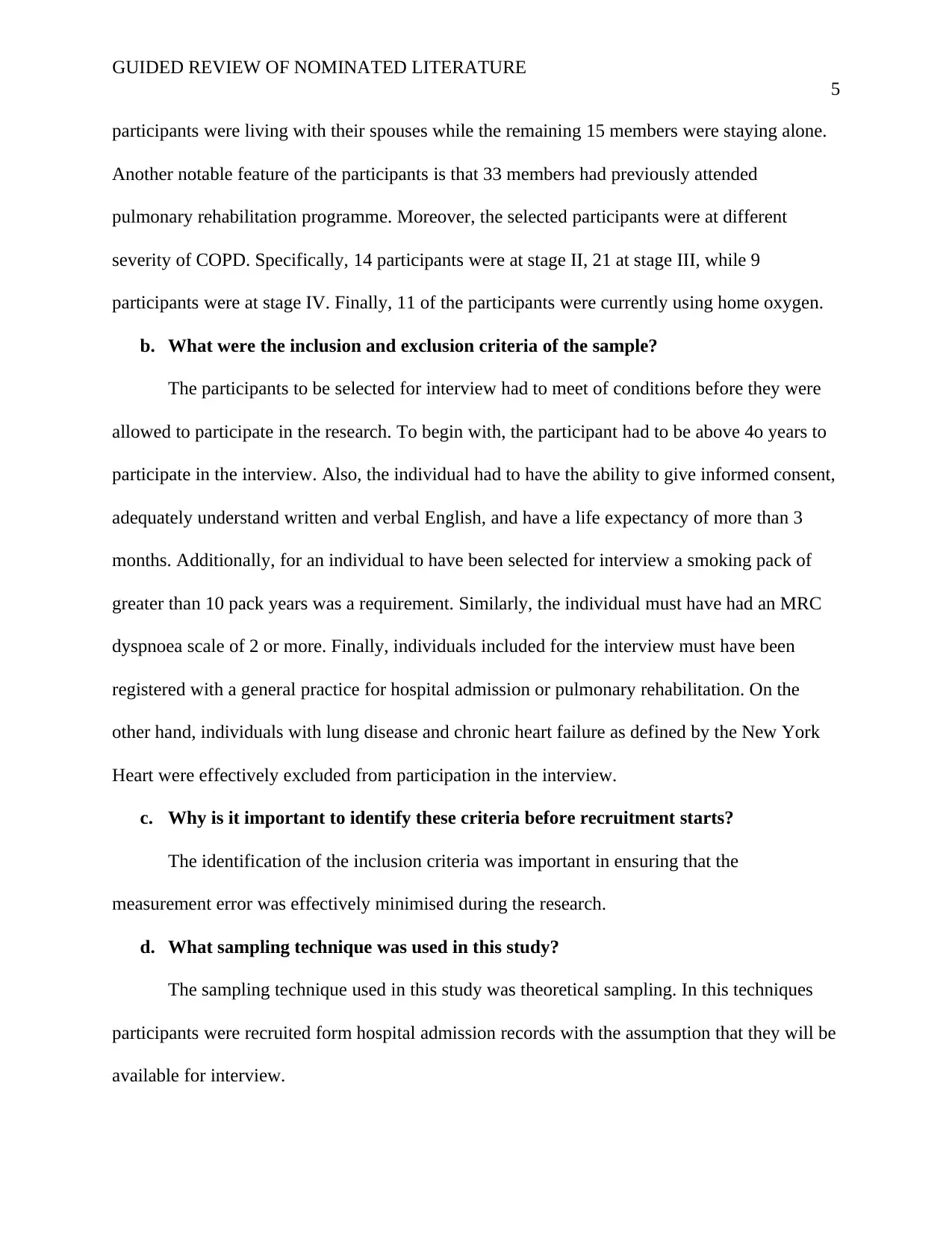
GUIDED REVIEW OF NOMINATED LITERATURE
5
participants were living with their spouses while the remaining 15 members were staying alone.
Another notable feature of the participants is that 33 members had previously attended
pulmonary rehabilitation programme. Moreover, the selected participants were at different
severity of COPD. Specifically, 14 participants were at stage II, 21 at stage III, while 9
participants were at stage IV. Finally, 11 of the participants were currently using home oxygen.
b. What were the inclusion and exclusion criteria of the sample?
The participants to be selected for interview had to meet of conditions before they were
allowed to participate in the research. To begin with, the participant had to be above 4o years to
participate in the interview. Also, the individual had to have the ability to give informed consent,
adequately understand written and verbal English, and have a life expectancy of more than 3
months. Additionally, for an individual to have been selected for interview a smoking pack of
greater than 10 pack years was a requirement. Similarly, the individual must have had an MRC
dyspnoea scale of 2 or more. Finally, individuals included for the interview must have been
registered with a general practice for hospital admission or pulmonary rehabilitation. On the
other hand, individuals with lung disease and chronic heart failure as defined by the New York
Heart were effectively excluded from participation in the interview.
c. Why is it important to identify these criteria before recruitment starts?
The identification of the inclusion criteria was important in ensuring that the
measurement error was effectively minimised during the research.
d. What sampling technique was used in this study?
The sampling technique used in this study was theoretical sampling. In this techniques
participants were recruited form hospital admission records with the assumption that they will be
available for interview.
5
participants were living with their spouses while the remaining 15 members were staying alone.
Another notable feature of the participants is that 33 members had previously attended
pulmonary rehabilitation programme. Moreover, the selected participants were at different
severity of COPD. Specifically, 14 participants were at stage II, 21 at stage III, while 9
participants were at stage IV. Finally, 11 of the participants were currently using home oxygen.
b. What were the inclusion and exclusion criteria of the sample?
The participants to be selected for interview had to meet of conditions before they were
allowed to participate in the research. To begin with, the participant had to be above 4o years to
participate in the interview. Also, the individual had to have the ability to give informed consent,
adequately understand written and verbal English, and have a life expectancy of more than 3
months. Additionally, for an individual to have been selected for interview a smoking pack of
greater than 10 pack years was a requirement. Similarly, the individual must have had an MRC
dyspnoea scale of 2 or more. Finally, individuals included for the interview must have been
registered with a general practice for hospital admission or pulmonary rehabilitation. On the
other hand, individuals with lung disease and chronic heart failure as defined by the New York
Heart were effectively excluded from participation in the interview.
c. Why is it important to identify these criteria before recruitment starts?
The identification of the inclusion criteria was important in ensuring that the
measurement error was effectively minimised during the research.
d. What sampling technique was used in this study?
The sampling technique used in this study was theoretical sampling. In this techniques
participants were recruited form hospital admission records with the assumption that they will be
available for interview.
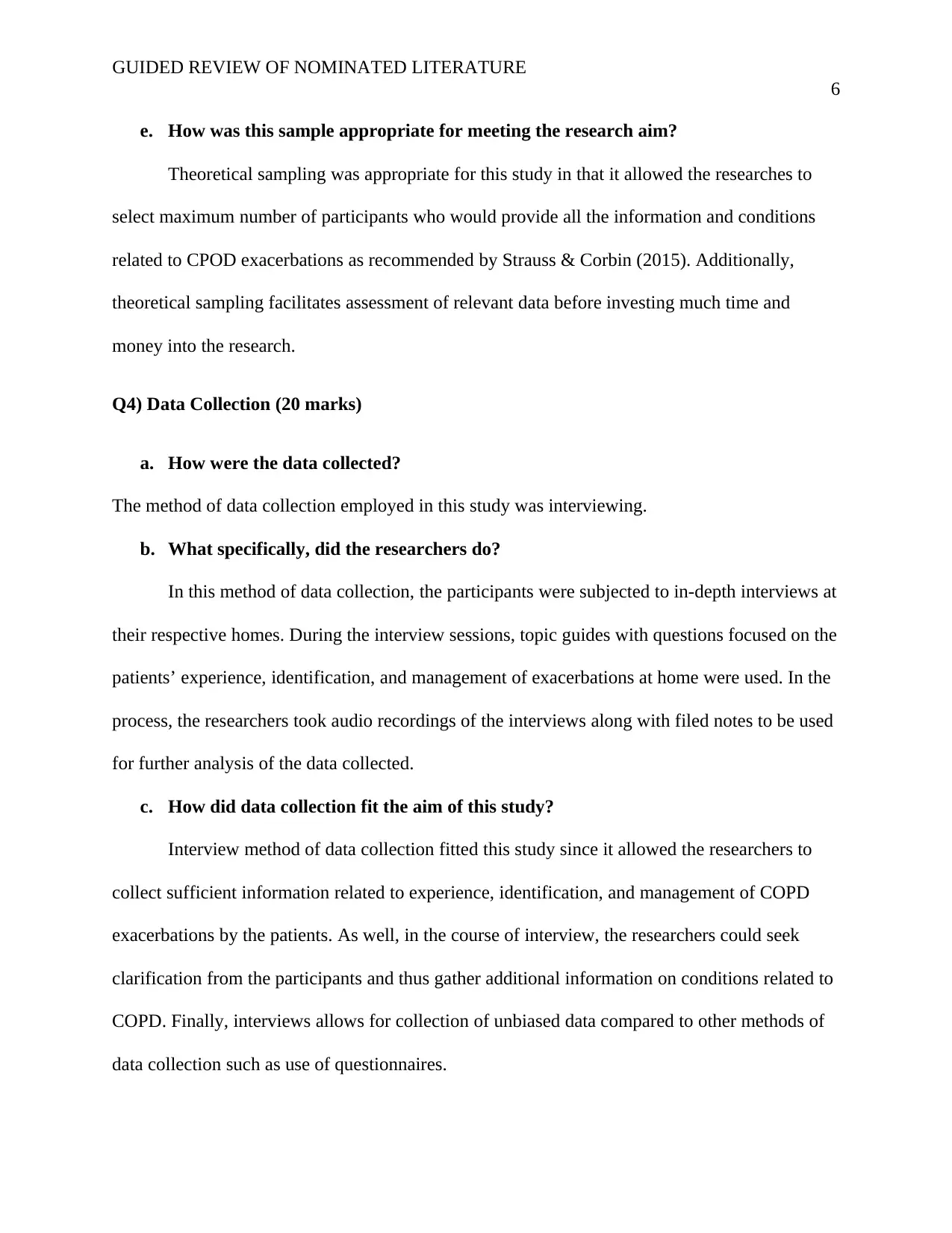
GUIDED REVIEW OF NOMINATED LITERATURE
6
e. How was this sample appropriate for meeting the research aim?
Theoretical sampling was appropriate for this study in that it allowed the researches to
select maximum number of participants who would provide all the information and conditions
related to CPOD exacerbations as recommended by Strauss & Corbin (2015). Additionally,
theoretical sampling facilitates assessment of relevant data before investing much time and
money into the research.
Q4) Data Collection (20 marks)
a. How were the data collected?
The method of data collection employed in this study was interviewing.
b. What specifically, did the researchers do?
In this method of data collection, the participants were subjected to in-depth interviews at
their respective homes. During the interview sessions, topic guides with questions focused on the
patients’ experience, identification, and management of exacerbations at home were used. In the
process, the researchers took audio recordings of the interviews along with filed notes to be used
for further analysis of the data collected.
c. How did data collection fit the aim of this study?
Interview method of data collection fitted this study since it allowed the researchers to
collect sufficient information related to experience, identification, and management of COPD
exacerbations by the patients. As well, in the course of interview, the researchers could seek
clarification from the participants and thus gather additional information on conditions related to
COPD. Finally, interviews allows for collection of unbiased data compared to other methods of
data collection such as use of questionnaires.
6
e. How was this sample appropriate for meeting the research aim?
Theoretical sampling was appropriate for this study in that it allowed the researches to
select maximum number of participants who would provide all the information and conditions
related to CPOD exacerbations as recommended by Strauss & Corbin (2015). Additionally,
theoretical sampling facilitates assessment of relevant data before investing much time and
money into the research.
Q4) Data Collection (20 marks)
a. How were the data collected?
The method of data collection employed in this study was interviewing.
b. What specifically, did the researchers do?
In this method of data collection, the participants were subjected to in-depth interviews at
their respective homes. During the interview sessions, topic guides with questions focused on the
patients’ experience, identification, and management of exacerbations at home were used. In the
process, the researchers took audio recordings of the interviews along with filed notes to be used
for further analysis of the data collected.
c. How did data collection fit the aim of this study?
Interview method of data collection fitted this study since it allowed the researchers to
collect sufficient information related to experience, identification, and management of COPD
exacerbations by the patients. As well, in the course of interview, the researchers could seek
clarification from the participants and thus gather additional information on conditions related to
COPD. Finally, interviews allows for collection of unbiased data compared to other methods of
data collection such as use of questionnaires.
⊘ This is a preview!⊘
Do you want full access?
Subscribe today to unlock all pages.

Trusted by 1+ million students worldwide
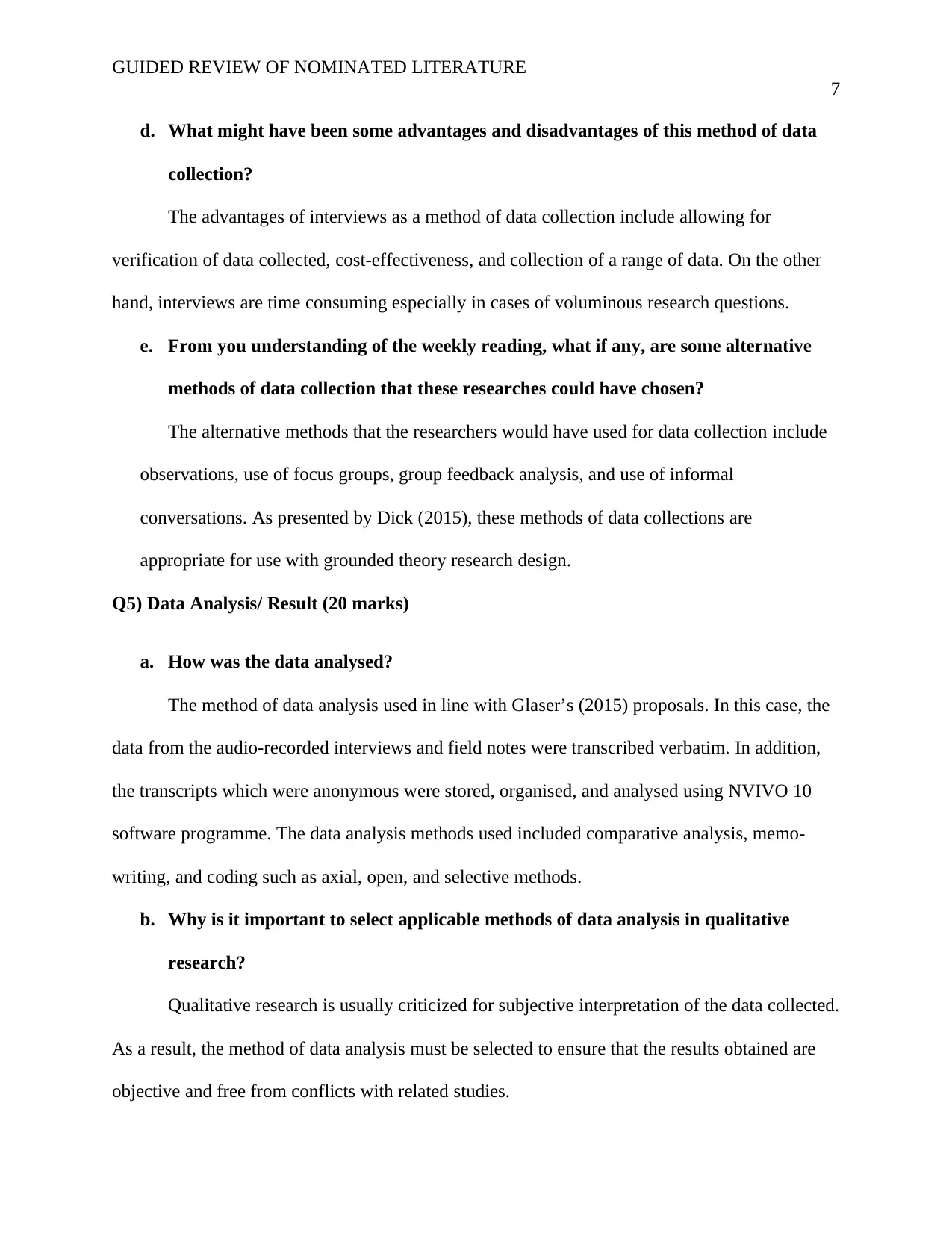
GUIDED REVIEW OF NOMINATED LITERATURE
7
d. What might have been some advantages and disadvantages of this method of data
collection?
The advantages of interviews as a method of data collection include allowing for
verification of data collected, cost-effectiveness, and collection of a range of data. On the other
hand, interviews are time consuming especially in cases of voluminous research questions.
e. From you understanding of the weekly reading, what if any, are some alternative
methods of data collection that these researches could have chosen?
The alternative methods that the researchers would have used for data collection include
observations, use of focus groups, group feedback analysis, and use of informal
conversations. As presented by Dick (2015), these methods of data collections are
appropriate for use with grounded theory research design.
Q5) Data Analysis/ Result (20 marks)
a. How was the data analysed?
The method of data analysis used in line with Glaser’s (2015) proposals. In this case, the
data from the audio-recorded interviews and field notes were transcribed verbatim. In addition,
the transcripts which were anonymous were stored, organised, and analysed using NVIVO 10
software programme. The data analysis methods used included comparative analysis, memo-
writing, and coding such as axial, open, and selective methods.
b. Why is it important to select applicable methods of data analysis in qualitative
research?
Qualitative research is usually criticized for subjective interpretation of the data collected.
As a result, the method of data analysis must be selected to ensure that the results obtained are
objective and free from conflicts with related studies.
7
d. What might have been some advantages and disadvantages of this method of data
collection?
The advantages of interviews as a method of data collection include allowing for
verification of data collected, cost-effectiveness, and collection of a range of data. On the other
hand, interviews are time consuming especially in cases of voluminous research questions.
e. From you understanding of the weekly reading, what if any, are some alternative
methods of data collection that these researches could have chosen?
The alternative methods that the researchers would have used for data collection include
observations, use of focus groups, group feedback analysis, and use of informal
conversations. As presented by Dick (2015), these methods of data collections are
appropriate for use with grounded theory research design.
Q5) Data Analysis/ Result (20 marks)
a. How was the data analysed?
The method of data analysis used in line with Glaser’s (2015) proposals. In this case, the
data from the audio-recorded interviews and field notes were transcribed verbatim. In addition,
the transcripts which were anonymous were stored, organised, and analysed using NVIVO 10
software programme. The data analysis methods used included comparative analysis, memo-
writing, and coding such as axial, open, and selective methods.
b. Why is it important to select applicable methods of data analysis in qualitative
research?
Qualitative research is usually criticized for subjective interpretation of the data collected.
As a result, the method of data analysis must be selected to ensure that the results obtained are
objective and free from conflicts with related studies.
Paraphrase This Document
Need a fresh take? Get an instant paraphrase of this document with our AI Paraphraser
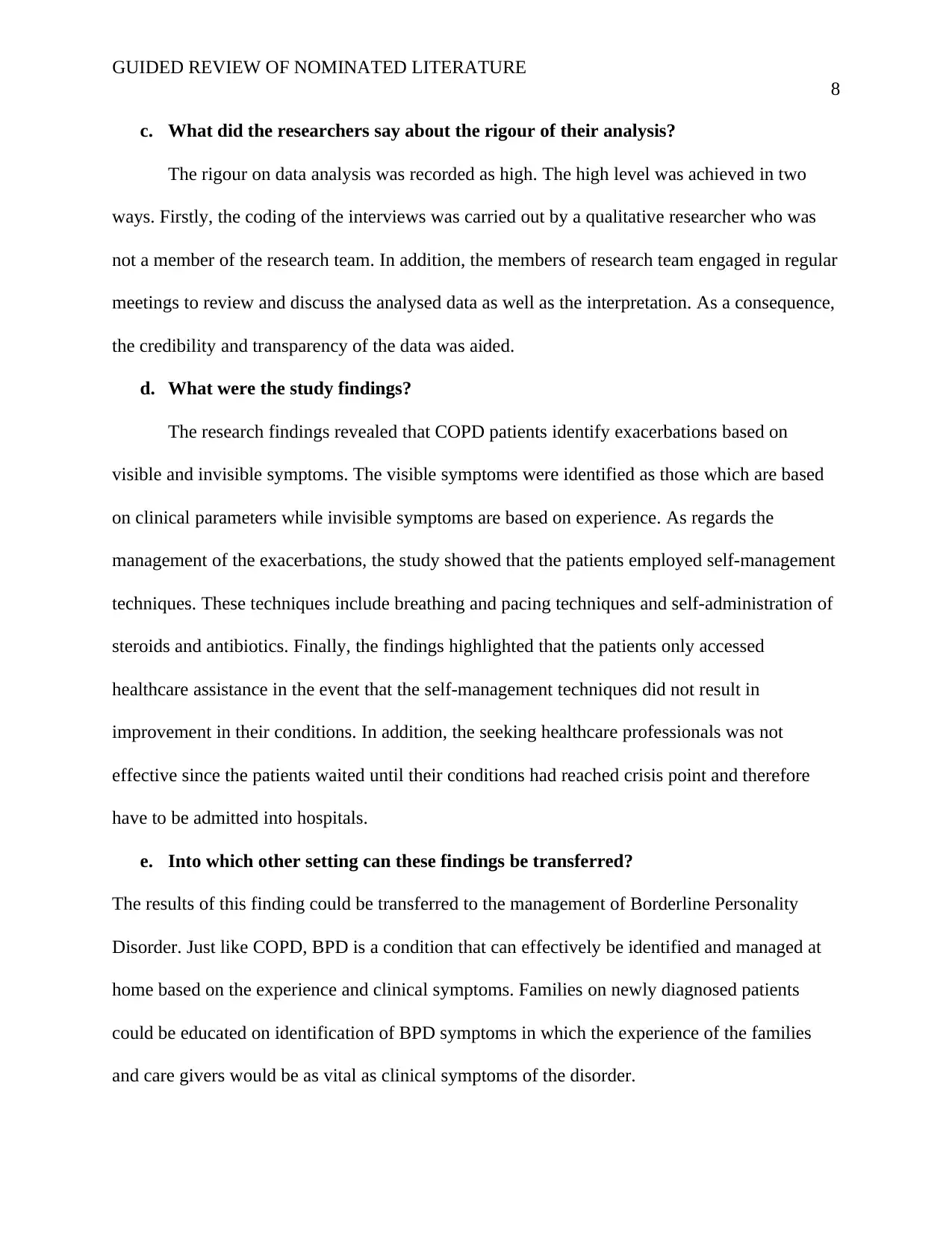
GUIDED REVIEW OF NOMINATED LITERATURE
8
c. What did the researchers say about the rigour of their analysis?
The rigour on data analysis was recorded as high. The high level was achieved in two
ways. Firstly, the coding of the interviews was carried out by a qualitative researcher who was
not a member of the research team. In addition, the members of research team engaged in regular
meetings to review and discuss the analysed data as well as the interpretation. As a consequence,
the credibility and transparency of the data was aided.
d. What were the study findings?
The research findings revealed that COPD patients identify exacerbations based on
visible and invisible symptoms. The visible symptoms were identified as those which are based
on clinical parameters while invisible symptoms are based on experience. As regards the
management of the exacerbations, the study showed that the patients employed self-management
techniques. These techniques include breathing and pacing techniques and self-administration of
steroids and antibiotics. Finally, the findings highlighted that the patients only accessed
healthcare assistance in the event that the self-management techniques did not result in
improvement in their conditions. In addition, the seeking healthcare professionals was not
effective since the patients waited until their conditions had reached crisis point and therefore
have to be admitted into hospitals.
e. Into which other setting can these findings be transferred?
The results of this finding could be transferred to the management of Borderline Personality
Disorder. Just like COPD, BPD is a condition that can effectively be identified and managed at
home based on the experience and clinical symptoms. Families on newly diagnosed patients
could be educated on identification of BPD symptoms in which the experience of the families
and care givers would be as vital as clinical symptoms of the disorder.
8
c. What did the researchers say about the rigour of their analysis?
The rigour on data analysis was recorded as high. The high level was achieved in two
ways. Firstly, the coding of the interviews was carried out by a qualitative researcher who was
not a member of the research team. In addition, the members of research team engaged in regular
meetings to review and discuss the analysed data as well as the interpretation. As a consequence,
the credibility and transparency of the data was aided.
d. What were the study findings?
The research findings revealed that COPD patients identify exacerbations based on
visible and invisible symptoms. The visible symptoms were identified as those which are based
on clinical parameters while invisible symptoms are based on experience. As regards the
management of the exacerbations, the study showed that the patients employed self-management
techniques. These techniques include breathing and pacing techniques and self-administration of
steroids and antibiotics. Finally, the findings highlighted that the patients only accessed
healthcare assistance in the event that the self-management techniques did not result in
improvement in their conditions. In addition, the seeking healthcare professionals was not
effective since the patients waited until their conditions had reached crisis point and therefore
have to be admitted into hospitals.
e. Into which other setting can these findings be transferred?
The results of this finding could be transferred to the management of Borderline Personality
Disorder. Just like COPD, BPD is a condition that can effectively be identified and managed at
home based on the experience and clinical symptoms. Families on newly diagnosed patients
could be educated on identification of BPD symptoms in which the experience of the families
and care givers would be as vital as clinical symptoms of the disorder.
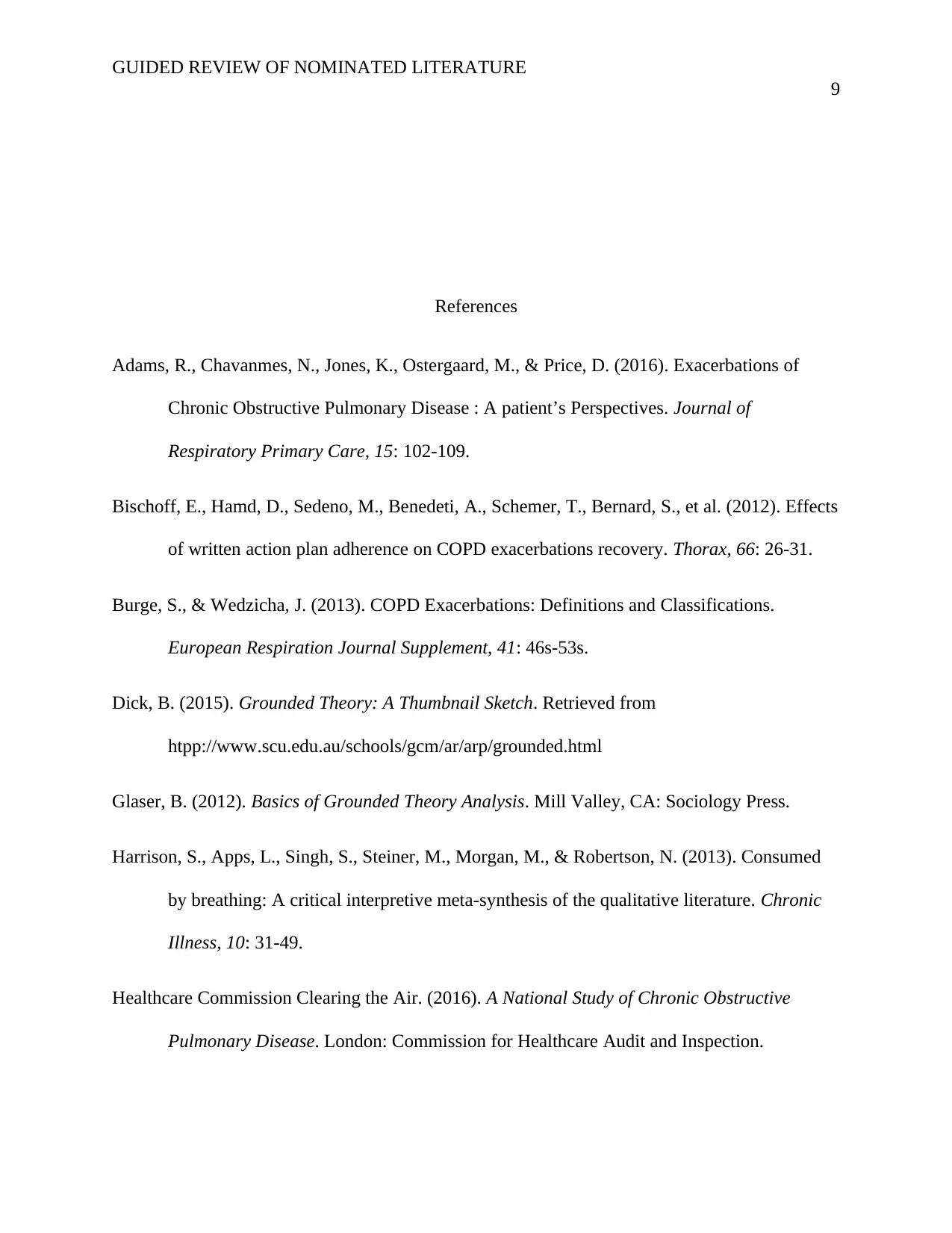
GUIDED REVIEW OF NOMINATED LITERATURE
9
References
Adams, R., Chavanmes, N., Jones, K., Ostergaard, M., & Price, D. (2016). Exacerbations of
Chronic Obstructive Pulmonary Disease : A patient’s Perspectives. Journal of
Respiratory Primary Care, 15: 102-109.
Bischoff, E., Hamd, D., Sedeno, M., Benedeti, A., Schemer, T., Bernard, S., et al. (2012). Effects
of written action plan adherence on COPD exacerbations recovery. Thorax, 66: 26-31.
Burge, S., & Wedzicha, J. (2013). COPD Exacerbations: Definitions and Classifications.
European Respiration Journal Supplement, 41: 46s-53s.
Dick, B. (2015). Grounded Theory: A Thumbnail Sketch. Retrieved from
htpp://www.scu.edu.au/schools/gcm/ar/arp/grounded.html
Glaser, B. (2012). Basics of Grounded Theory Analysis. Mill Valley, CA: Sociology Press.
Harrison, S., Apps, L., Singh, S., Steiner, M., Morgan, M., & Robertson, N. (2013). Consumed
by breathing: A critical interpretive meta-synthesis of the qualitative literature. Chronic
Illness, 10: 31-49.
Healthcare Commission Clearing the Air. (2016). A National Study of Chronic Obstructive
Pulmonary Disease. London: Commission for Healthcare Audit and Inspection.
9
References
Adams, R., Chavanmes, N., Jones, K., Ostergaard, M., & Price, D. (2016). Exacerbations of
Chronic Obstructive Pulmonary Disease : A patient’s Perspectives. Journal of
Respiratory Primary Care, 15: 102-109.
Bischoff, E., Hamd, D., Sedeno, M., Benedeti, A., Schemer, T., Bernard, S., et al. (2012). Effects
of written action plan adherence on COPD exacerbations recovery. Thorax, 66: 26-31.
Burge, S., & Wedzicha, J. (2013). COPD Exacerbations: Definitions and Classifications.
European Respiration Journal Supplement, 41: 46s-53s.
Dick, B. (2015). Grounded Theory: A Thumbnail Sketch. Retrieved from
htpp://www.scu.edu.au/schools/gcm/ar/arp/grounded.html
Glaser, B. (2012). Basics of Grounded Theory Analysis. Mill Valley, CA: Sociology Press.
Harrison, S., Apps, L., Singh, S., Steiner, M., Morgan, M., & Robertson, N. (2013). Consumed
by breathing: A critical interpretive meta-synthesis of the qualitative literature. Chronic
Illness, 10: 31-49.
Healthcare Commission Clearing the Air. (2016). A National Study of Chronic Obstructive
Pulmonary Disease. London: Commission for Healthcare Audit and Inspection.
⊘ This is a preview!⊘
Do you want full access?
Subscribe today to unlock all pages.

Trusted by 1+ million students worldwide
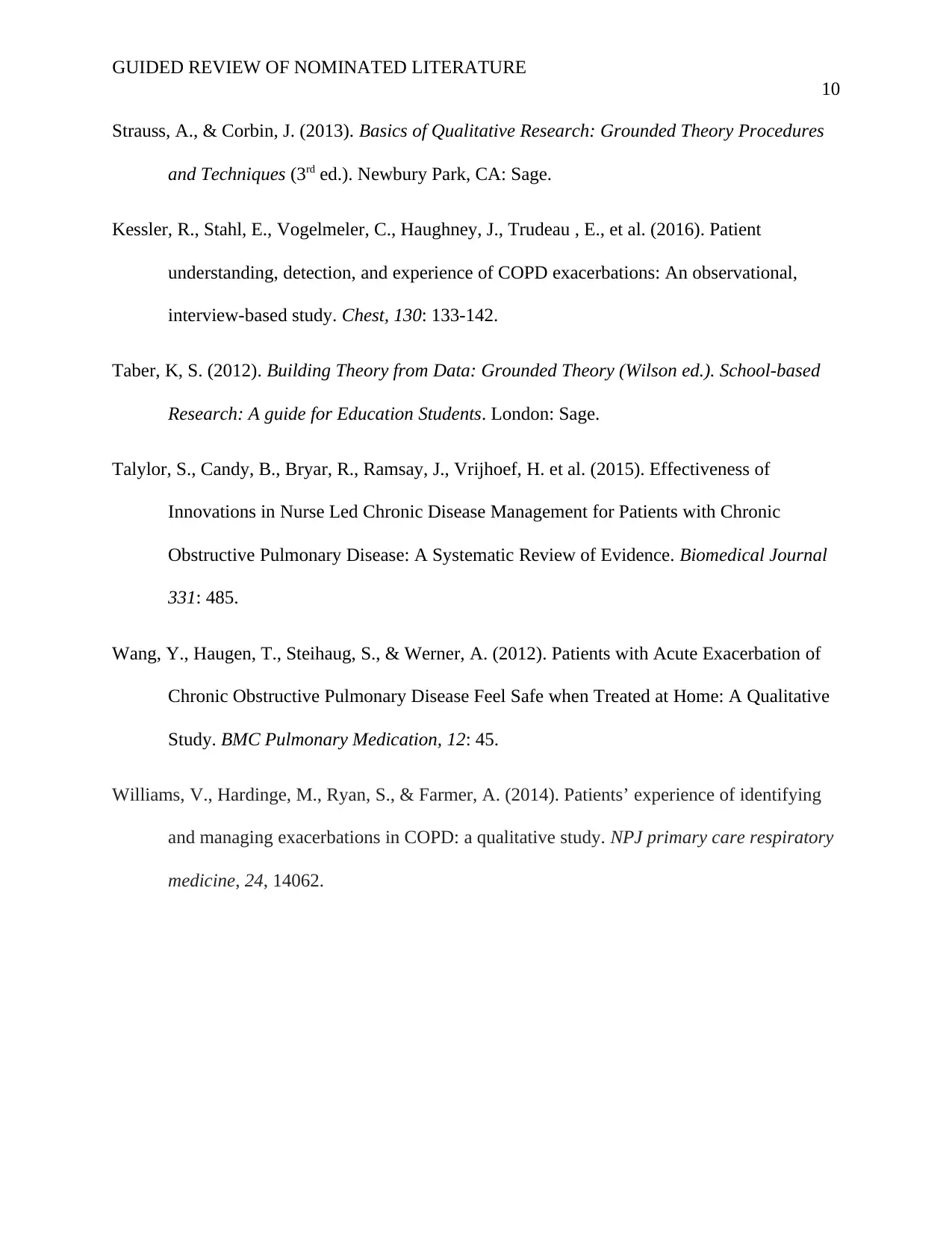
GUIDED REVIEW OF NOMINATED LITERATURE
10
Strauss, A., & Corbin, J. (2013). Basics of Qualitative Research: Grounded Theory Procedures
and Techniques (3rd ed.). Newbury Park, CA: Sage.
Kessler, R., Stahl, E., Vogelmeler, C., Haughney, J., Trudeau , E., et al. (2016). Patient
understanding, detection, and experience of COPD exacerbations: An observational,
interview-based study. Chest, 130: 133-142.
Taber, K, S. (2012). Building Theory from Data: Grounded Theory (Wilson ed.). School-based
Research: A guide for Education Students. London: Sage.
Talylor, S., Candy, B., Bryar, R., Ramsay, J., Vrijhoef, H. et al. (2015). Effectiveness of
Innovations in Nurse Led Chronic Disease Management for Patients with Chronic
Obstructive Pulmonary Disease: A Systematic Review of Evidence. Biomedical Journal
331: 485.
Wang, Y., Haugen, T., Steihaug, S., & Werner, A. (2012). Patients with Acute Exacerbation of
Chronic Obstructive Pulmonary Disease Feel Safe when Treated at Home: A Qualitative
Study. BMC Pulmonary Medication, 12: 45.
Williams, V., Hardinge, M., Ryan, S., & Farmer, A. (2014). Patients’ experience of identifying
and managing exacerbations in COPD: a qualitative study. NPJ primary care respiratory
medicine, 24, 14062.
10
Strauss, A., & Corbin, J. (2013). Basics of Qualitative Research: Grounded Theory Procedures
and Techniques (3rd ed.). Newbury Park, CA: Sage.
Kessler, R., Stahl, E., Vogelmeler, C., Haughney, J., Trudeau , E., et al. (2016). Patient
understanding, detection, and experience of COPD exacerbations: An observational,
interview-based study. Chest, 130: 133-142.
Taber, K, S. (2012). Building Theory from Data: Grounded Theory (Wilson ed.). School-based
Research: A guide for Education Students. London: Sage.
Talylor, S., Candy, B., Bryar, R., Ramsay, J., Vrijhoef, H. et al. (2015). Effectiveness of
Innovations in Nurse Led Chronic Disease Management for Patients with Chronic
Obstructive Pulmonary Disease: A Systematic Review of Evidence. Biomedical Journal
331: 485.
Wang, Y., Haugen, T., Steihaug, S., & Werner, A. (2012). Patients with Acute Exacerbation of
Chronic Obstructive Pulmonary Disease Feel Safe when Treated at Home: A Qualitative
Study. BMC Pulmonary Medication, 12: 45.
Williams, V., Hardinge, M., Ryan, S., & Farmer, A. (2014). Patients’ experience of identifying
and managing exacerbations in COPD: a qualitative study. NPJ primary care respiratory
medicine, 24, 14062.
1 out of 10
Related Documents
Your All-in-One AI-Powered Toolkit for Academic Success.
+13062052269
info@desklib.com
Available 24*7 on WhatsApp / Email
![[object Object]](/_next/static/media/star-bottom.7253800d.svg)
Unlock your academic potential
Copyright © 2020–2025 A2Z Services. All Rights Reserved. Developed and managed by ZUCOL.




